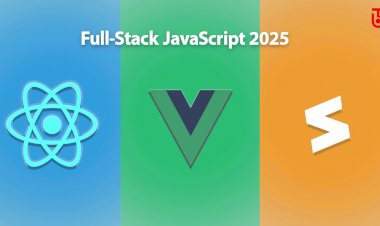Frontend Frameworks 2025: React vs Vue vs Angular vs Svelte - The Complete Developer's Guide
23 May 2025
Choosing the right frontend framework in 2025 can make or break your project's success. With React, Vue, Angular, and Svelte dominating the landscape, developers face a challenging decision that impacts performance, development speed, and long-term maintenance.
This comprehensive guide analyzes the top four frontend frameworks, examining their strengths, weaknesses, and ideal use cases to help you make an informed decision for your next project.
Market Share and Popularity in 2025
The frontend framework ecosystem has evolved significantly, with each framework carving out its niche:
React continues to lead with approximately 40% market share, backed by Meta's resources and a massive ecosystem. Its virtual DOM approach and component-based architecture remain popular among enterprise developers.
Angular maintains strong enterprise adoption at 22% market share, particularly in large-scale applications requiring robust architecture and TypeScript integration out of the box.
Vue.js holds steady at 18% market share, praised for its gentle learning curve and excellent documentation, making it ideal for both beginners and experienced developers.
Svelte has gained remarkable traction, reaching 12% market share in 2025, with developers loving its compile-time optimizations and minimal runtime overhead.
React: The Ecosystem Champion
Strengths
React's greatest asset remains its vast ecosystem and community support. The framework offers unparalleled flexibility with numerous third-party libraries, making it suitable for projects of any scale.
Performance: React 18's concurrent features and automatic batching have significantly improved performance. The new Suspense boundaries and streaming server-side rendering deliver better user experiences.
Developer Experience: Tools like React DevTools, Hot Reloading, and extensive documentation make development efficient. The introduction of React Server Components has simplified data fetching patterns.
Job Market: React skills remain highly sought after, with the highest number of job opportunities among all frontend frameworks.
Weaknesses
The learning curve can be steep for beginners, particularly understanding concepts like hooks, context, and state management patterns. The rapid pace of updates sometimes leads to deprecated practices and frequent refactoring.
Bundle Size: React applications often suffer from larger bundle sizes compared to compiled frameworks like Svelte.
Best Use Cases
- Large-scale enterprise applications
- Projects requiring extensive third-party integrations
- Teams with React expertise
- Applications needing server-side rendering with Next.js
Vue.js: The Developer-Friendly Choice
Strengths
Vue.js excels in developer experience with its intuitive template syntax and comprehensive documentation. The Composition API introduced in Vue 3 provides better code organization for complex components.
Learning Curve: Vue offers the gentlest learning curve among major frameworks, making it accessible to developers transitioning from jQuery or vanilla JavaScript.
Performance: Vue 3's Proxy-based reactivity system delivers excellent performance with minimal boilerplate code. The framework's size optimization keeps bundle sizes reasonable.
Versatility: Vue works equally well for small projects and large applications, with a progressive adoption approach that allows gradual integration into existing projects.
Weaknesses
The ecosystem, while growing, remains smaller than React's. Enterprise adoption lags behind React and Angular, potentially limiting career opportunities.
Community: Although passionate, Vue's community is smaller, which can mean fewer resources and third-party solutions for niche problems.
Best Use Cases
- Rapid prototyping and MVP development
- Small to medium-sized applications
- Teams transitioning from jQuery
- Projects requiring quick development cycles
Angular: The Enterprise Powerhouse
Strengths
Angular provides a complete, opinionated framework with everything needed for large-scale application development. TypeScript integration, dependency injection, and comprehensive CLI tools create a robust development environment.
Architecture: Angular's architecture promotes best practices with services, modules, and dependency injection, making code maintainable in large teams.
Tooling: The Angular CLI automates many development tasks, from project scaffolding to deployment preparation. Built-in testing utilities and code generation save significant development time.
Enterprise Features: Features like internationalization, accessibility tools, and form handling make Angular ideal for complex business applications.
Weaknesses
The steep learning curve and complex concepts can overwhelm newcomers. Angular applications often have larger bundle sizes and slower initial load times compared to other frameworks.
Flexibility: Angular's opinionated nature can feel restrictive for developers preferring more flexibility in their architecture choices.
Best Use Cases
- Large enterprise applications
- Projects requiring strict coding standards
- Teams familiar with TypeScript and object-oriented programming
- Applications needing comprehensive built-in features
Svelte: The Performance Revolutionary
Strengths
Svelte's compile-time approach eliminates the need for a virtual DOM, resulting in smaller bundle sizes and faster runtime performance. The framework generates vanilla JavaScript, reducing the overhead associated with framework abstractions.
Performance: Svelte applications consistently outperform other frameworks in speed benchmarks, particularly for initial load times and runtime performance.
Developer Experience: The learning curve is moderate, with a syntax that feels familiar to developers with HTML, CSS, and JavaScript experience. The reactive nature of Svelte reduces boilerplate code significantly.
Innovation: SvelteKit, the framework's meta-framework, provides modern features like server-side rendering, code splitting, and progressive enhancement out of the box.
Weaknesses
The ecosystem remains limited compared to established frameworks, with fewer third-party components and libraries available. The job market for Svelte developers is smaller but growing rapidly.
Maturity: As a newer framework, Svelte may lack some enterprise-grade features and has a smaller community for troubleshooting complex issues.
Best Use Cases
- Performance-critical applications
- Projects where bundle size matters
- Developer teams excited about cutting-edge technology
- Applications requiring smooth animations and interactions
Performance Comparison 2025
When evaluating framework performance, consider multiple metrics:
Bundle Size: Svelte produces the smallest bundles, followed by Vue, React, and Angular. For a typical todo application, bundle sizes average: Svelte (10KB), Vue (30KB), React (42KB), Angular (130KB).
Runtime Performance: Svelte and Vue lead in runtime performance benchmarks, with React and Angular following closely. The differences become more pronounced in complex applications with frequent DOM updates.
Memory Usage: Svelte's compiled approach results in lower memory consumption, while Angular applications typically use more memory due to their comprehensive feature set.
Load Times: Initial page load times favor Svelte and Vue, particularly on slower networks and devices. React and Angular applications require optimization strategies to achieve similar performance.
Learning Curve and Developer Experience
Easiest to Learn: Vue.js offers the most approachable learning experience, with excellent documentation and intuitive concepts.
Moderate Learning Curve: Svelte and React require moderate investment to master, with Svelte being slightly more approachable for developers new to modern frameworks.
Steepest Learning Curve: Angular demands significant upfront learning investment, particularly for developers unfamiliar with TypeScript and enterprise development patterns.
Ecosystem and Community Support
React boasts the largest ecosystem with solutions for virtually every development need. The community actively contributes libraries, tools, and educational content.
Angular provides a comprehensive ecosystem focused on enterprise development, with official solutions for most common requirements.
Vue offers a growing ecosystem with high-quality official and community libraries. The community is known for its helpfulness and detailed documentation.
Svelte has a smaller but rapidly growing ecosystem. While fewer third-party options exist, the community focuses on quality over quantity.
Job Market and Career Prospects
The demand for frontend framework skills varies significantly:
React dominates job postings, with opportunities ranging from startups to Fortune 500 companies. Salaries remain competitive across all experience levels.
Angular shows strong demand in enterprise and government sectors, often commanding premium salaries due to the framework's complexity.
Vue opportunities are growing, particularly in agencies and mid-sized companies. The demand often exceeds the supply of experienced Vue developers.
Svelte represents an emerging market with limited but growing opportunities, often found in innovative companies and performance-focused projects.
Framework Selection Guide
Choose React when:
- Building large-scale applications with complex requirements
- Working with a team experienced in React ecosystem
- Requiring extensive third-party integrations
- Prioritizing long-term career prospects
Choose Vue when:
- Developing rapid prototypes or MVPs
- Working with mixed-skill teams
- Requiring gentle learning curve
- Building small to medium applications
Choose Angular when:
- Developing enterprise-grade applications
- Working with large development teams
- Requiring comprehensive built-in features
- Building applications with complex business logic
Choose Svelte when:
- Performance is a critical requirement
- Building content-heavy websites
- Working on innovative projects
- Bundle size optimization is essential
Future Outlook: What to Expect in 2025-2026
The frontend landscape continues evolving rapidly:
React will likely maintain its leadership position while focusing on server components and performance optimizations. The upcoming React 19 promises further improvements to developer experience.
Angular continues its evolution toward better performance and developer experience, with ongoing improvements to the framework's architecture and tooling.
Vue is expected to grow its enterprise adoption while maintaining its reputation for developer-friendly features. Vue 4 development focuses on performance improvements and better TypeScript integration.
Svelte shows the most growth potential, with increasing adoption in performance-critical applications and growing ecosystem support.
Making Your Decision
The choice between React, Vue, Angular, and Svelte ultimately depends on your specific project requirements, team expertise, and long-term goals. Consider these factors:
- Project Scale: Small projects benefit from Vue or Svelte, while large applications often require React or Angular
- Team Experience: Leverage existing team knowledge when possible
- Performance Requirements: Choose Svelte or Vue for performance-critical applications
- Ecosystem Needs: React offers the most extensive third-party options
- Timeline: Vue and Svelte often enable faster development cycles
Each framework has evolved to excel in specific scenarios. React dominates enterprise development, Vue excels in rapid development, Angular powers complex business applications, and Svelte leads in performance optimization.
The frontend framework you choose today will impact your project for years to come. Consider your team's expertise, project requirements, and long-term maintenance needs when making this crucial decision.
Remember that framework selection is just one aspect of successful frontend development. Focus on understanding fundamental web technologies, maintaining code quality, and creating excellent user experiences regardless of your chosen framework.


